Social Work Practice: Exploring Theories and Methods for Intervention
VerifiedAdded on 2022/12/29
|15
|5086
|81
Report
AI Summary
This report delves into the application of various social work theories and methods to analyze a case study, focusing on the ASPIRE model (Assess, Plan, Intervene, Review, Evaluate). It begins with an introduction highlighting the importance of social work theories in understanding and addressing s...
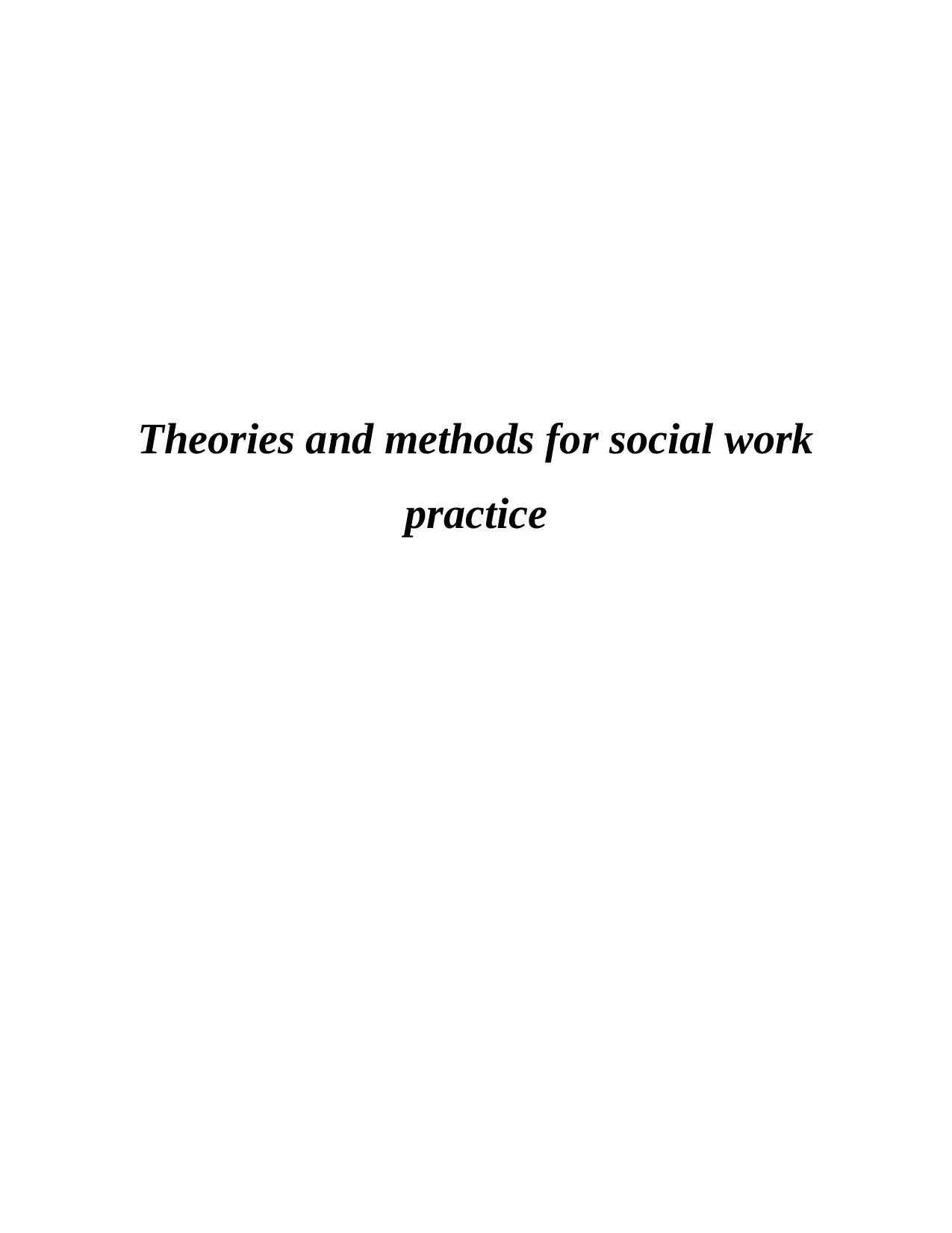
Theories and methods for social work
practice
practice
Paraphrase This Document
Need a fresh take? Get an instant paraphrase of this document with our AI Paraphraser
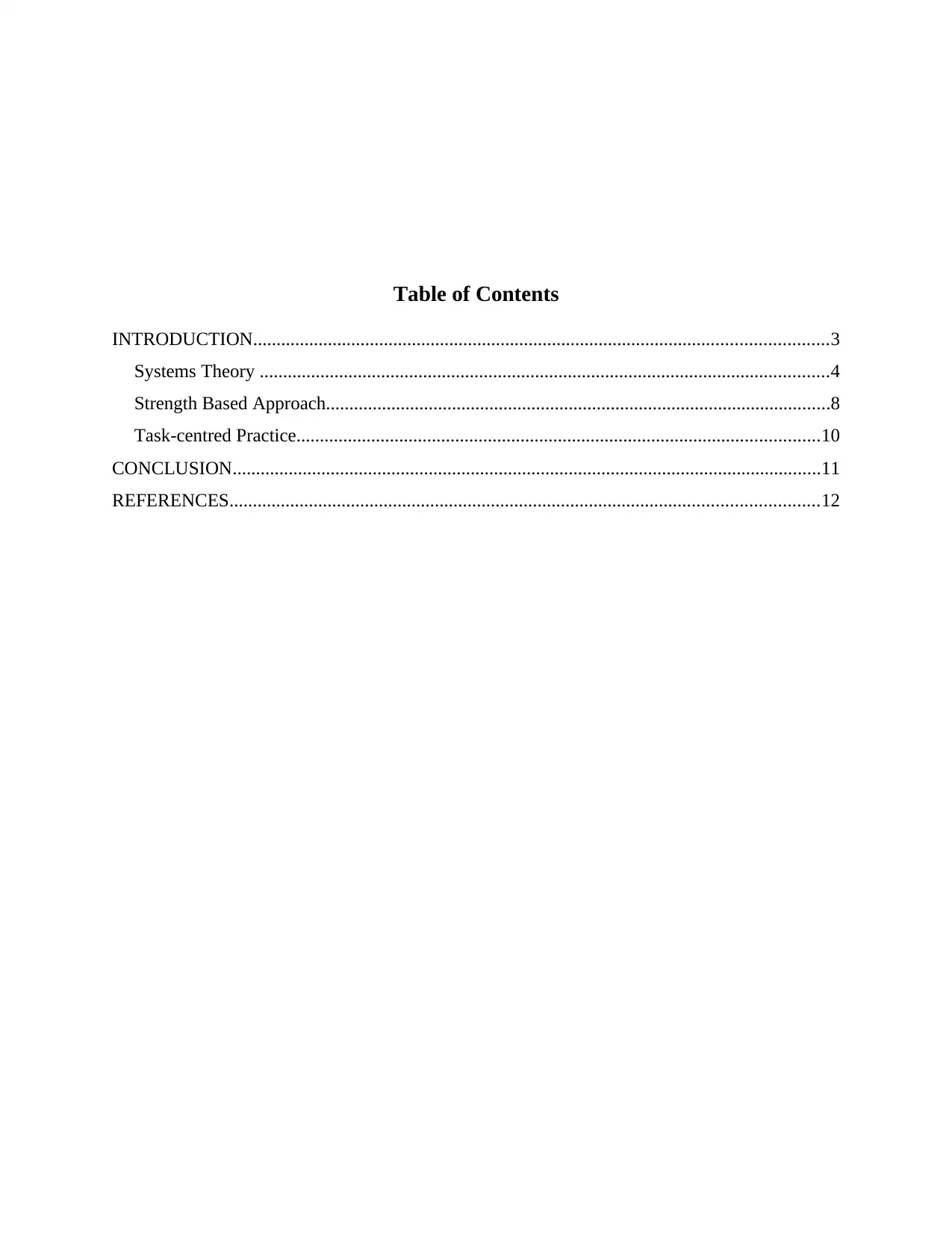
Table of Contents
INTRODUCTION...........................................................................................................................3
Systems Theory ..........................................................................................................................4
Strength Based Approach............................................................................................................8
Task-centred Practice................................................................................................................10
CONCLUSION..............................................................................................................................11
REFERENCES..............................................................................................................................12
INTRODUCTION...........................................................................................................................3
Systems Theory ..........................................................................................................................4
Strength Based Approach............................................................................................................8
Task-centred Practice................................................................................................................10
CONCLUSION..............................................................................................................................11
REFERENCES..............................................................................................................................12
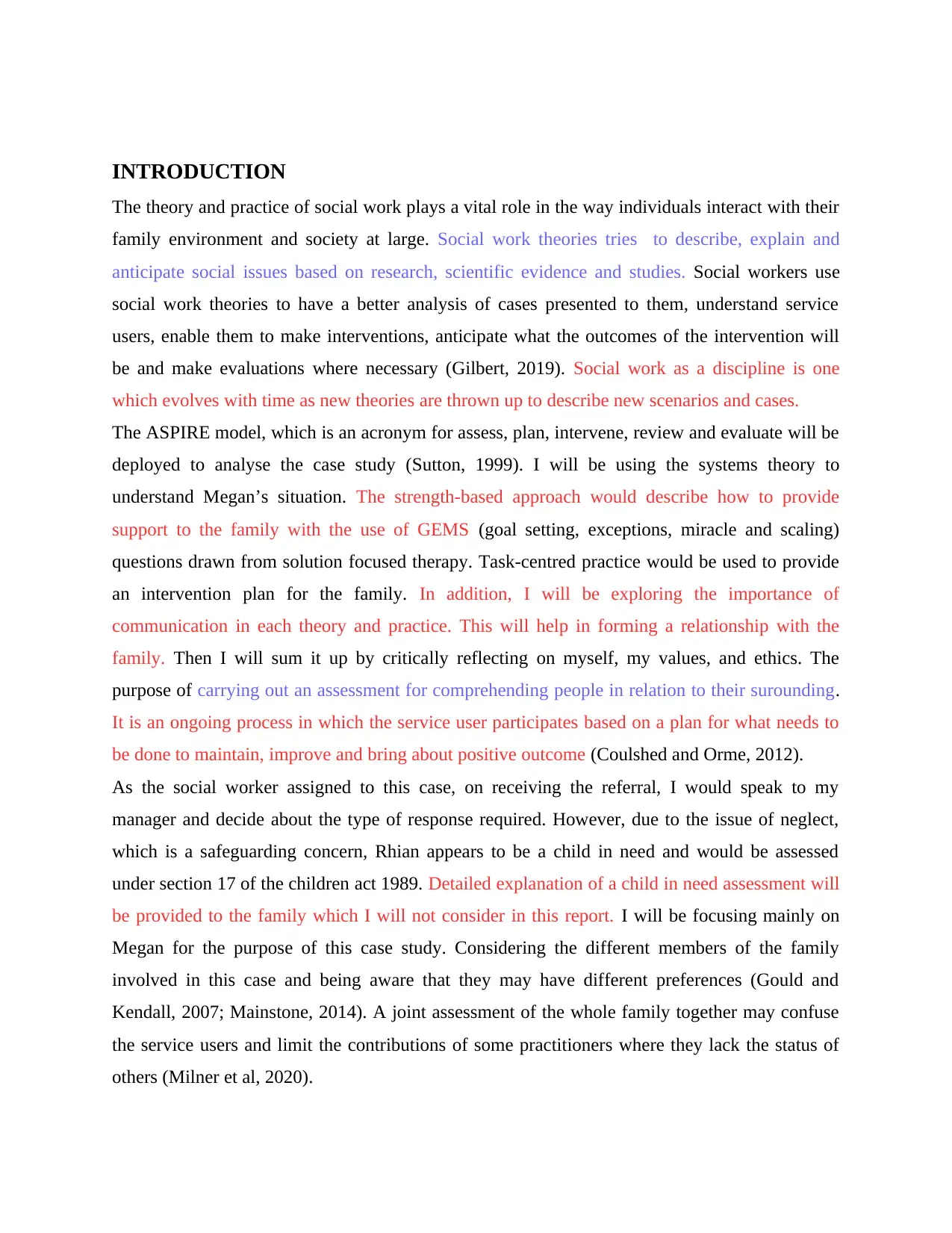
INTRODUCTION
The theory and practice of social work plays a vital role in the way individuals interact with their
family environment and society at large. Social work theories tries to describe, explain and
anticipate social issues based on research, scientific evidence and studies. Social workers use
social work theories to have a better analysis of cases presented to them, understand service
users, enable them to make interventions, anticipate what the outcomes of the intervention will
be and make evaluations where necessary (Gilbert, 2019). Social work as a discipline is one
which evolves with time as new theories are thrown up to describe new scenarios and cases.
The ASPIRE model, which is an acronym for assess, plan, intervene, review and evaluate will be
deployed to analyse the case study (Sutton, 1999). I will be using the systems theory to
understand Megan’s situation. The strength-based approach would describe how to provide
support to the family with the use of GEMS (goal setting, exceptions, miracle and scaling)
questions drawn from solution focused therapy. Task-centred practice would be used to provide
an intervention plan for the family. In addition, I will be exploring the importance of
communication in each theory and practice. This will help in forming a relationship with the
family. Then I will sum it up by critically reflecting on myself, my values, and ethics. The
purpose of carrying out an assessment for comprehending people in relation to their surounding.
It is an ongoing process in which the service user participates based on a plan for what needs to
be done to maintain, improve and bring about positive outcome (Coulshed and Orme, 2012).
As the social worker assigned to this case, on receiving the referral, I would speak to my
manager and decide about the type of response required. However, due to the issue of neglect,
which is a safeguarding concern, Rhian appears to be a child in need and would be assessed
under section 17 of the children act 1989. Detailed explanation of a child in need assessment will
be provided to the family which I will not consider in this report. I will be focusing mainly on
Megan for the purpose of this case study. Considering the different members of the family
involved in this case and being aware that they may have different preferences (Gould and
Kendall, 2007; Mainstone, 2014). A joint assessment of the whole family together may confuse
the service users and limit the contributions of some practitioners where they lack the status of
others (Milner et al, 2020).
The theory and practice of social work plays a vital role in the way individuals interact with their
family environment and society at large. Social work theories tries to describe, explain and
anticipate social issues based on research, scientific evidence and studies. Social workers use
social work theories to have a better analysis of cases presented to them, understand service
users, enable them to make interventions, anticipate what the outcomes of the intervention will
be and make evaluations where necessary (Gilbert, 2019). Social work as a discipline is one
which evolves with time as new theories are thrown up to describe new scenarios and cases.
The ASPIRE model, which is an acronym for assess, plan, intervene, review and evaluate will be
deployed to analyse the case study (Sutton, 1999). I will be using the systems theory to
understand Megan’s situation. The strength-based approach would describe how to provide
support to the family with the use of GEMS (goal setting, exceptions, miracle and scaling)
questions drawn from solution focused therapy. Task-centred practice would be used to provide
an intervention plan for the family. In addition, I will be exploring the importance of
communication in each theory and practice. This will help in forming a relationship with the
family. Then I will sum it up by critically reflecting on myself, my values, and ethics. The
purpose of carrying out an assessment for comprehending people in relation to their surounding.
It is an ongoing process in which the service user participates based on a plan for what needs to
be done to maintain, improve and bring about positive outcome (Coulshed and Orme, 2012).
As the social worker assigned to this case, on receiving the referral, I would speak to my
manager and decide about the type of response required. However, due to the issue of neglect,
which is a safeguarding concern, Rhian appears to be a child in need and would be assessed
under section 17 of the children act 1989. Detailed explanation of a child in need assessment will
be provided to the family which I will not consider in this report. I will be focusing mainly on
Megan for the purpose of this case study. Considering the different members of the family
involved in this case and being aware that they may have different preferences (Gould and
Kendall, 2007; Mainstone, 2014). A joint assessment of the whole family together may confuse
the service users and limit the contributions of some practitioners where they lack the status of
others (Milner et al, 2020).
⊘ This is a preview!⊘
Do you want full access?
Subscribe today to unlock all pages.

Trusted by 1+ million students worldwide
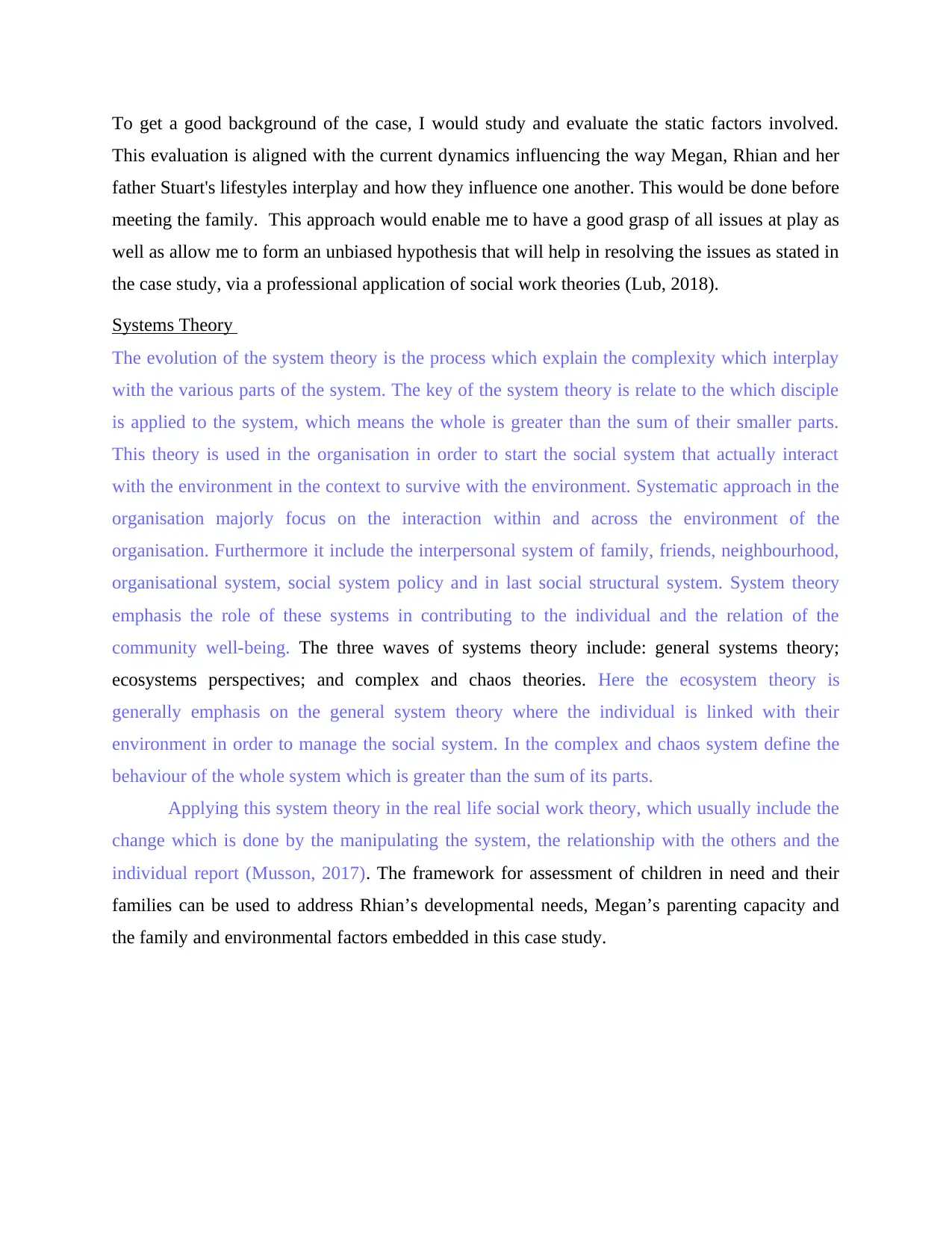
To get a good background of the case, I would study and evaluate the static factors involved.
This evaluation is aligned with the current dynamics influencing the way Megan, Rhian and her
father Stuart's lifestyles interplay and how they influence one another. This would be done before
meeting the family. This approach would enable me to have a good grasp of all issues at play as
well as allow me to form an unbiased hypothesis that will help in resolving the issues as stated in
the case study, via a professional application of social work theories (Lub, 2018).
Systems Theory
The evolution of the system theory is the process which explain the complexity which interplay
with the various parts of the system. The key of the system theory is relate to the which disciple
is applied to the system, which means the whole is greater than the sum of their smaller parts.
This theory is used in the organisation in order to start the social system that actually interact
with the environment in the context to survive with the environment. Systematic approach in the
organisation majorly focus on the interaction within and across the environment of the
organisation. Furthermore it include the interpersonal system of family, friends, neighbourhood,
organisational system, social system policy and in last social structural system. System theory
emphasis the role of these systems in contributing to the individual and the relation of the
community well-being. The three waves of systems theory include: general systems theory;
ecosystems perspectives; and complex and chaos theories. Here the ecosystem theory is
generally emphasis on the general system theory where the individual is linked with their
environment in order to manage the social system. In the complex and chaos system define the
behaviour of the whole system which is greater than the sum of its parts.
Applying this system theory in the real life social work theory, which usually include the
change which is done by the manipulating the system, the relationship with the others and the
individual report (Musson, 2017). The framework for assessment of children in need and their
families can be used to address Rhian’s developmental needs, Megan’s parenting capacity and
the family and environmental factors embedded in this case study.
This evaluation is aligned with the current dynamics influencing the way Megan, Rhian and her
father Stuart's lifestyles interplay and how they influence one another. This would be done before
meeting the family. This approach would enable me to have a good grasp of all issues at play as
well as allow me to form an unbiased hypothesis that will help in resolving the issues as stated in
the case study, via a professional application of social work theories (Lub, 2018).
Systems Theory
The evolution of the system theory is the process which explain the complexity which interplay
with the various parts of the system. The key of the system theory is relate to the which disciple
is applied to the system, which means the whole is greater than the sum of their smaller parts.
This theory is used in the organisation in order to start the social system that actually interact
with the environment in the context to survive with the environment. Systematic approach in the
organisation majorly focus on the interaction within and across the environment of the
organisation. Furthermore it include the interpersonal system of family, friends, neighbourhood,
organisational system, social system policy and in last social structural system. System theory
emphasis the role of these systems in contributing to the individual and the relation of the
community well-being. The three waves of systems theory include: general systems theory;
ecosystems perspectives; and complex and chaos theories. Here the ecosystem theory is
generally emphasis on the general system theory where the individual is linked with their
environment in order to manage the social system. In the complex and chaos system define the
behaviour of the whole system which is greater than the sum of its parts.
Applying this system theory in the real life social work theory, which usually include the
change which is done by the manipulating the system, the relationship with the others and the
individual report (Musson, 2017). The framework for assessment of children in need and their
families can be used to address Rhian’s developmental needs, Megan’s parenting capacity and
the family and environmental factors embedded in this case study.
Paraphrase This Document
Need a fresh take? Get an instant paraphrase of this document with our AI Paraphraser
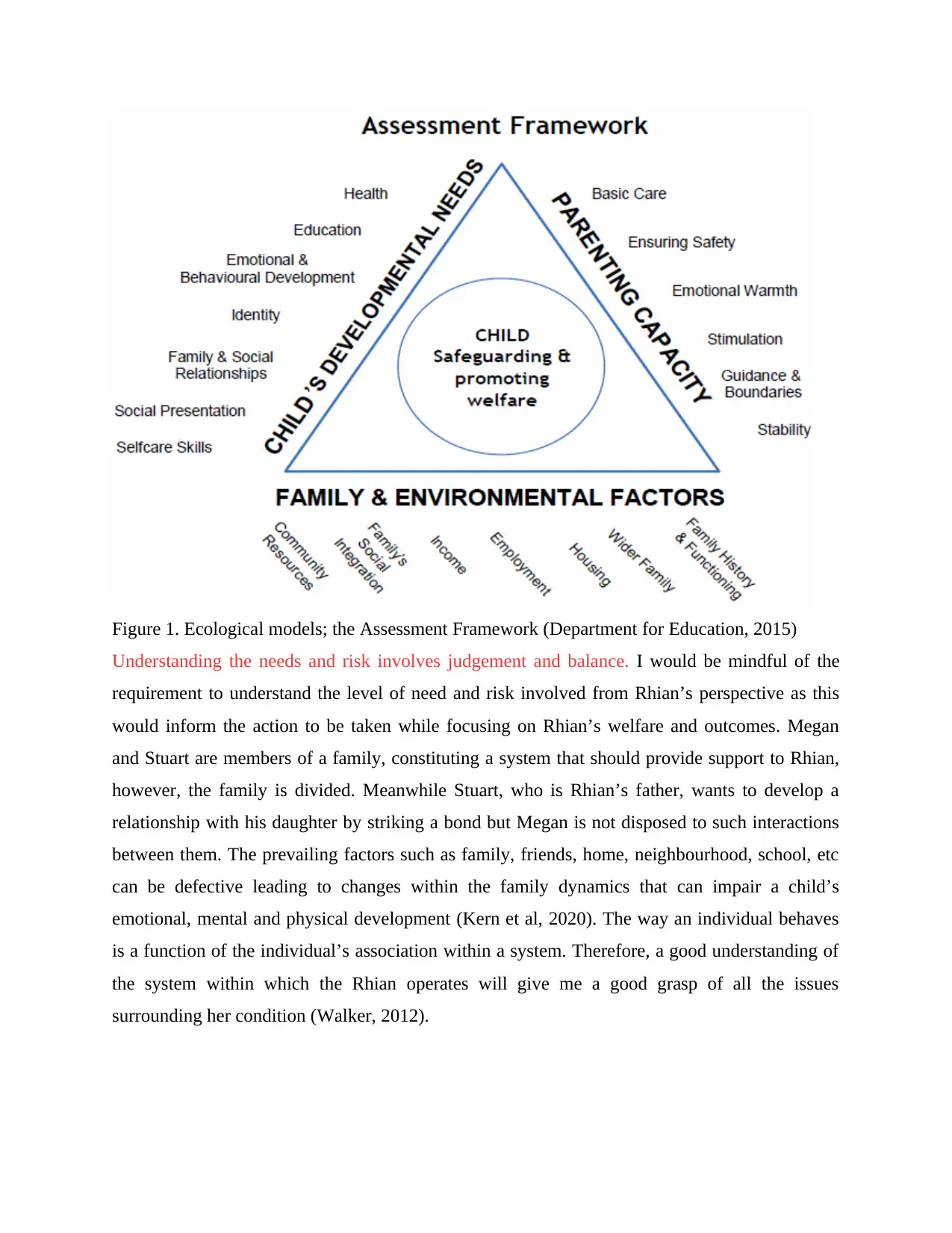
Figure 1. Ecological models; the Assessment Framework (Department for Education, 2015)
Understanding the needs and risk involves judgement and balance. I would be mindful of the
requirement to understand the level of need and risk involved from Rhian’s perspective as this
would inform the action to be taken while focusing on Rhian’s welfare and outcomes. Megan
and Stuart are members of a family, constituting a system that should provide support to Rhian,
however, the family is divided. Meanwhile Stuart, who is Rhian’s father, wants to develop a
relationship with his daughter by striking a bond but Megan is not disposed to such interactions
between them. The prevailing factors such as family, friends, home, neighbourhood, school, etc
can be defective leading to changes within the family dynamics that can impair a child’s
emotional, mental and physical development (Kern et al, 2020). The way an individual behaves
is a function of the individual’s association within a system. Therefore, a good understanding of
the system within which the Rhian operates will give me a good grasp of all the issues
surrounding her condition (Walker, 2012).
Understanding the needs and risk involves judgement and balance. I would be mindful of the
requirement to understand the level of need and risk involved from Rhian’s perspective as this
would inform the action to be taken while focusing on Rhian’s welfare and outcomes. Megan
and Stuart are members of a family, constituting a system that should provide support to Rhian,
however, the family is divided. Meanwhile Stuart, who is Rhian’s father, wants to develop a
relationship with his daughter by striking a bond but Megan is not disposed to such interactions
between them. The prevailing factors such as family, friends, home, neighbourhood, school, etc
can be defective leading to changes within the family dynamics that can impair a child’s
emotional, mental and physical development (Kern et al, 2020). The way an individual behaves
is a function of the individual’s association within a system. Therefore, a good understanding of
the system within which the Rhian operates will give me a good grasp of all the issues
surrounding her condition (Walker, 2012).
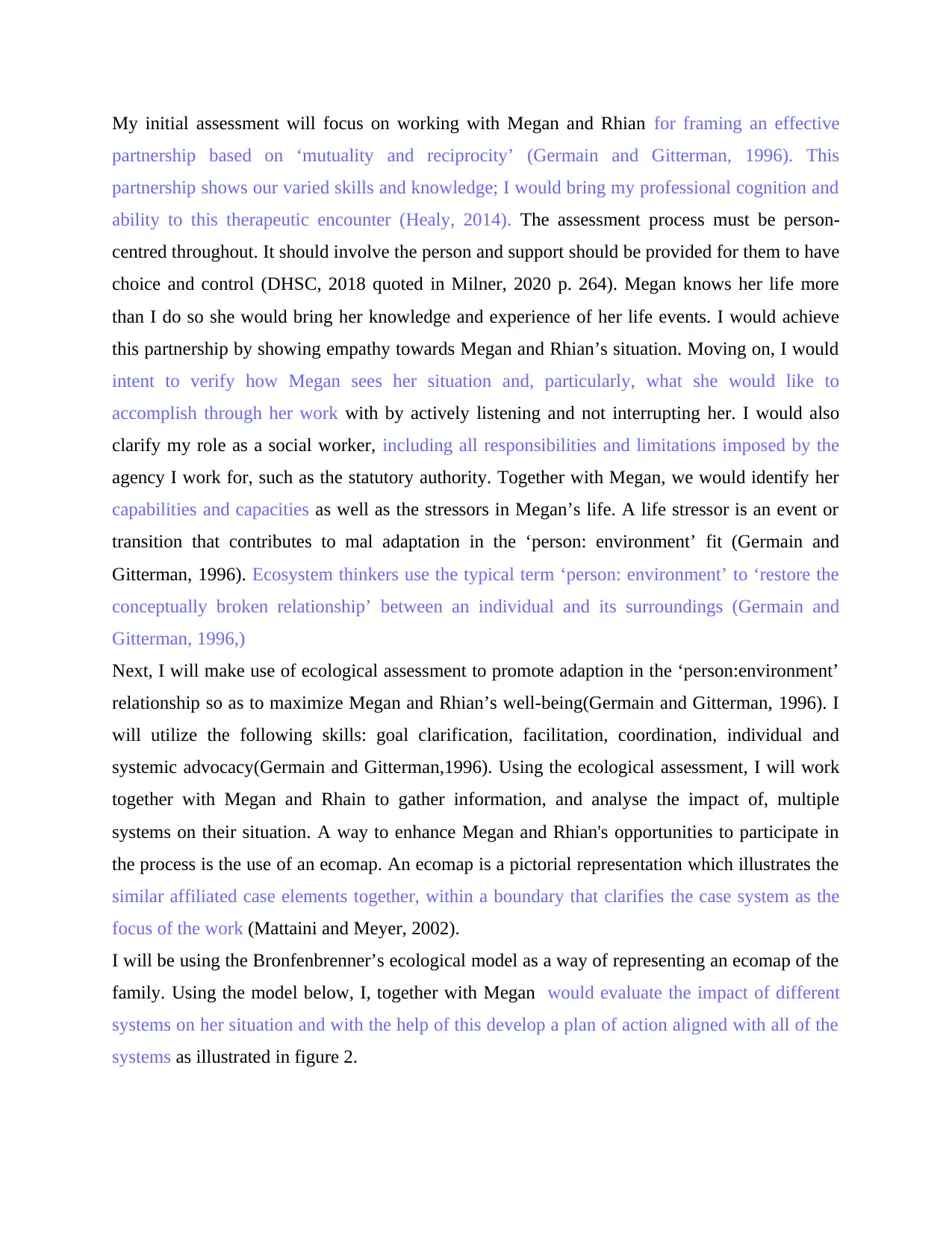
My initial assessment will focus on working with Megan and Rhian for framing an effective
partnership based on ‘mutuality and reciprocity’ (Germain and Gitterman, 1996). This
partnership shows our varied skills and knowledge; I would bring my professional cognition and
ability to this therapeutic encounter (Healy, 2014). The assessment process must be person-
centred throughout. It should involve the person and support should be provided for them to have
choice and control (DHSC, 2018 quoted in Milner, 2020 p. 264). Megan knows her life more
than I do so she would bring her knowledge and experience of her life events. I would achieve
this partnership by showing empathy towards Megan and Rhian’s situation. Moving on, I would
intent to verify how Megan sees her situation and, particularly, what she would like to
accomplish through her work with by actively listening and not interrupting her. I would also
clarify my role as a social worker, including all responsibilities and limitations imposed by the
agency I work for, such as the statutory authority. Together with Megan, we would identify her
capabilities and capacities as well as the stressors in Megan’s life. A life stressor is an event or
transition that contributes to mal adaptation in the ‘person: environment’ fit (Germain and
Gitterman, 1996). Ecosystem thinkers use the typical term ‘person: environment’ to ‘restore the
conceptually broken relationship’ between an individual and its surroundings (Germain and
Gitterman, 1996,)
Next, I will make use of ecological assessment to promote adaption in the ‘person:environment’
relationship so as to maximize Megan and Rhian’s well-being(Germain and Gitterman, 1996). I
will utilize the following skills: goal clarification, facilitation, coordination, individual and
systemic advocacy(Germain and Gitterman,1996). Using the ecological assessment, I will work
together with Megan and Rhain to gather information, and analyse the impact of, multiple
systems on their situation. A way to enhance Megan and Rhian's opportunities to participate in
the process is the use of an ecomap. An ecomap is a pictorial representation which illustrates the
similar affiliated case elements together, within a boundary that clarifies the case system as the
focus of the work (Mattaini and Meyer, 2002).
I will be using the Bronfenbrenner’s ecological model as a way of representing an ecomap of the
family. Using the model below, I, together with Megan would evaluate the impact of different
systems on her situation and with the help of this develop a plan of action aligned with all of the
systems as illustrated in figure 2.
partnership based on ‘mutuality and reciprocity’ (Germain and Gitterman, 1996). This
partnership shows our varied skills and knowledge; I would bring my professional cognition and
ability to this therapeutic encounter (Healy, 2014). The assessment process must be person-
centred throughout. It should involve the person and support should be provided for them to have
choice and control (DHSC, 2018 quoted in Milner, 2020 p. 264). Megan knows her life more
than I do so she would bring her knowledge and experience of her life events. I would achieve
this partnership by showing empathy towards Megan and Rhian’s situation. Moving on, I would
intent to verify how Megan sees her situation and, particularly, what she would like to
accomplish through her work with by actively listening and not interrupting her. I would also
clarify my role as a social worker, including all responsibilities and limitations imposed by the
agency I work for, such as the statutory authority. Together with Megan, we would identify her
capabilities and capacities as well as the stressors in Megan’s life. A life stressor is an event or
transition that contributes to mal adaptation in the ‘person: environment’ fit (Germain and
Gitterman, 1996). Ecosystem thinkers use the typical term ‘person: environment’ to ‘restore the
conceptually broken relationship’ between an individual and its surroundings (Germain and
Gitterman, 1996,)
Next, I will make use of ecological assessment to promote adaption in the ‘person:environment’
relationship so as to maximize Megan and Rhian’s well-being(Germain and Gitterman, 1996). I
will utilize the following skills: goal clarification, facilitation, coordination, individual and
systemic advocacy(Germain and Gitterman,1996). Using the ecological assessment, I will work
together with Megan and Rhain to gather information, and analyse the impact of, multiple
systems on their situation. A way to enhance Megan and Rhian's opportunities to participate in
the process is the use of an ecomap. An ecomap is a pictorial representation which illustrates the
similar affiliated case elements together, within a boundary that clarifies the case system as the
focus of the work (Mattaini and Meyer, 2002).
I will be using the Bronfenbrenner’s ecological model as a way of representing an ecomap of the
family. Using the model below, I, together with Megan would evaluate the impact of different
systems on her situation and with the help of this develop a plan of action aligned with all of the
systems as illustrated in figure 2.
⊘ This is a preview!⊘
Do you want full access?
Subscribe today to unlock all pages.

Trusted by 1+ million students worldwide
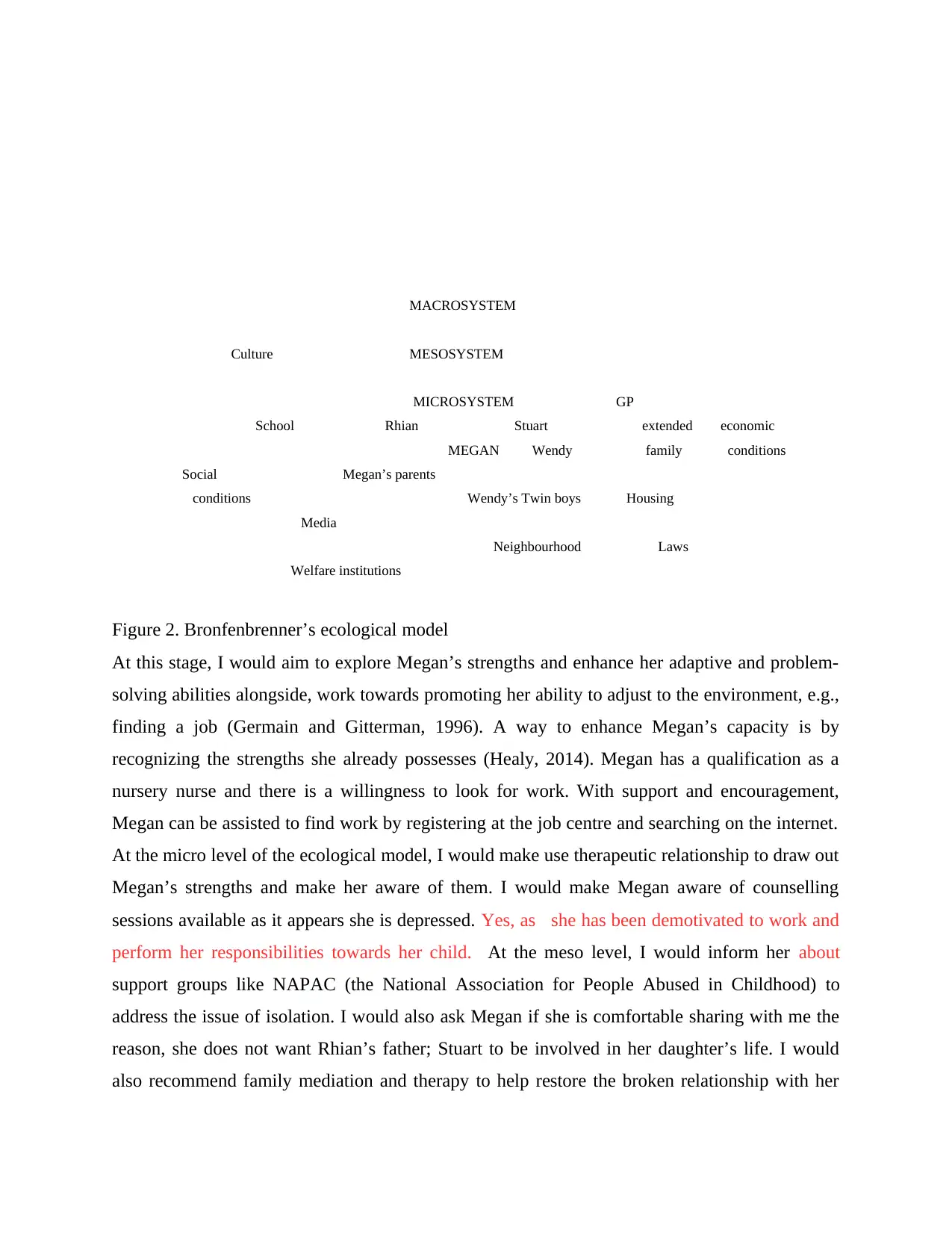
MACROSYSTEM
Culture MESOSYSTEM
MICROSYSTEM GP
School Rhian Stuart extended economic
MEGAN Wendy family conditions
Social Megan’s parents
conditions Wendy’s Twin boys Housing
Media
Neighbourhood Laws
Welfare institutions
Figure 2. Bronfenbrenner’s ecological model
At this stage, I would aim to explore Megan’s strengths and enhance her adaptive and problem-
solving abilities alongside, work towards promoting her ability to adjust to the environment, e.g.,
finding a job (Germain and Gitterman, 1996). A way to enhance Megan’s capacity is by
recognizing the strengths she already possesses (Healy, 2014). Megan has a qualification as a
nursery nurse and there is a willingness to look for work. With support and encouragement,
Megan can be assisted to find work by registering at the job centre and searching on the internet.
At the micro level of the ecological model, I would make use therapeutic relationship to draw out
Megan’s strengths and make her aware of them. I would make Megan aware of counselling
sessions available as it appears she is depressed. Yes, as she has been demotivated to work and
perform her responsibilities towards her child. At the meso level, I would inform her about
support groups like NAPAC (the National Association for People Abused in Childhood) to
address the issue of isolation. I would also ask Megan if she is comfortable sharing with me the
reason, she does not want Rhian’s father; Stuart to be involved in her daughter’s life. I would
also recommend family mediation and therapy to help restore the broken relationship with her
Culture MESOSYSTEM
MICROSYSTEM GP
School Rhian Stuart extended economic
MEGAN Wendy family conditions
Social Megan’s parents
conditions Wendy’s Twin boys Housing
Media
Neighbourhood Laws
Welfare institutions
Figure 2. Bronfenbrenner’s ecological model
At this stage, I would aim to explore Megan’s strengths and enhance her adaptive and problem-
solving abilities alongside, work towards promoting her ability to adjust to the environment, e.g.,
finding a job (Germain and Gitterman, 1996). A way to enhance Megan’s capacity is by
recognizing the strengths she already possesses (Healy, 2014). Megan has a qualification as a
nursery nurse and there is a willingness to look for work. With support and encouragement,
Megan can be assisted to find work by registering at the job centre and searching on the internet.
At the micro level of the ecological model, I would make use therapeutic relationship to draw out
Megan’s strengths and make her aware of them. I would make Megan aware of counselling
sessions available as it appears she is depressed. Yes, as she has been demotivated to work and
perform her responsibilities towards her child. At the meso level, I would inform her about
support groups like NAPAC (the National Association for People Abused in Childhood) to
address the issue of isolation. I would also ask Megan if she is comfortable sharing with me the
reason, she does not want Rhian’s father; Stuart to be involved in her daughter’s life. I would
also recommend family mediation and therapy to help restore the broken relationship with her
Paraphrase This Document
Need a fresh take? Get an instant paraphrase of this document with our AI Paraphraser
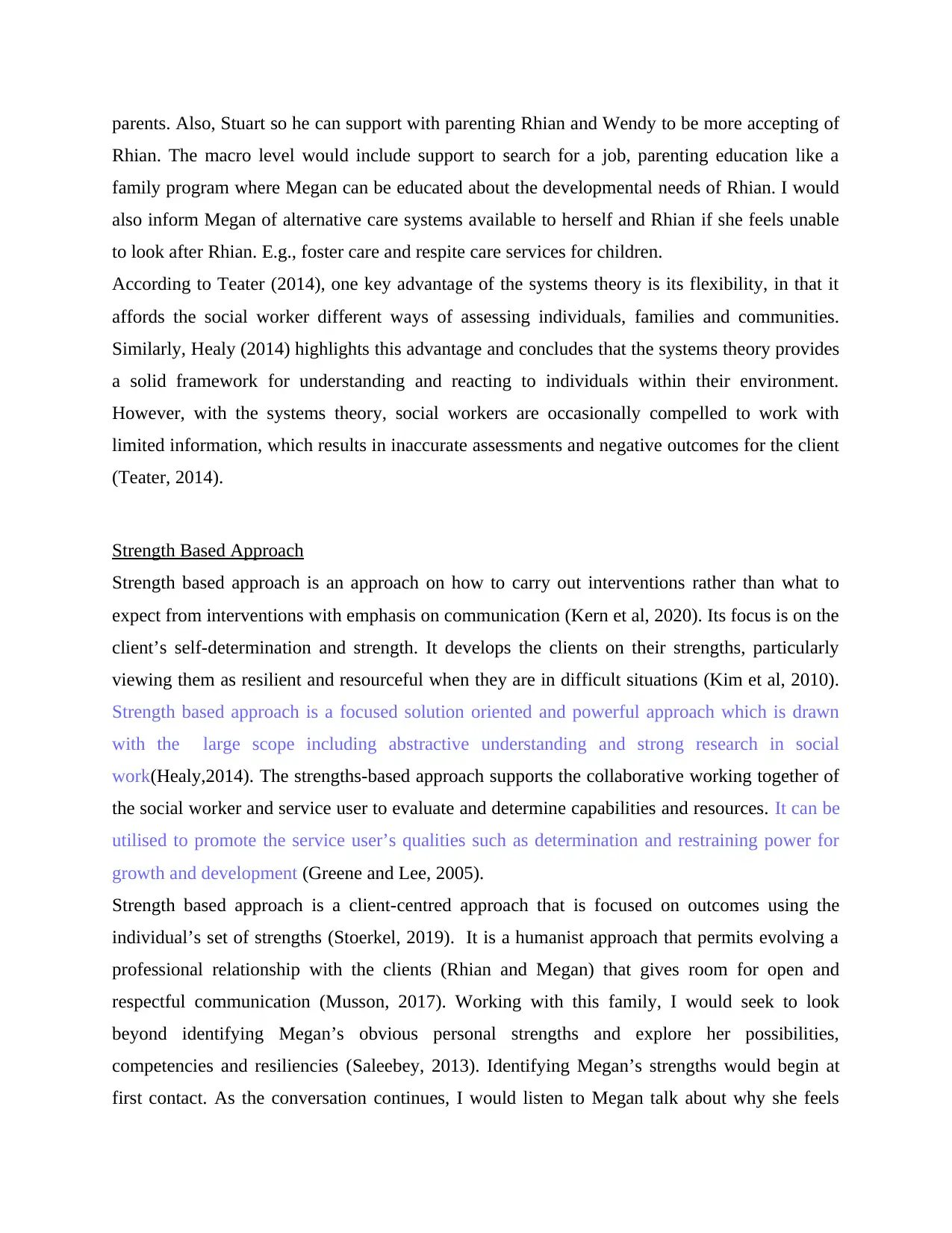
parents. Also, Stuart so he can support with parenting Rhian and Wendy to be more accepting of
Rhian. The macro level would include support to search for a job, parenting education like a
family program where Megan can be educated about the developmental needs of Rhian. I would
also inform Megan of alternative care systems available to herself and Rhian if she feels unable
to look after Rhian. E.g., foster care and respite care services for children.
According to Teater (2014), one key advantage of the systems theory is its flexibility, in that it
affords the social worker different ways of assessing individuals, families and communities.
Similarly, Healy (2014) highlights this advantage and concludes that the systems theory provides
a solid framework for understanding and reacting to individuals within their environment.
However, with the systems theory, social workers are occasionally compelled to work with
limited information, which results in inaccurate assessments and negative outcomes for the client
(Teater, 2014).
Strength Based Approach
Strength based approach is an approach on how to carry out interventions rather than what to
expect from interventions with emphasis on communication (Kern et al, 2020). Its focus is on the
client’s self-determination and strength. It develops the clients on their strengths, particularly
viewing them as resilient and resourceful when they are in difficult situations (Kim et al, 2010).
Strength based approach is a focused solution oriented and powerful approach which is drawn
with the large scope including abstractive understanding and strong research in social
work(Healy,2014). The strengths-based approach supports the collaborative working together of
the social worker and service user to evaluate and determine capabilities and resources. It can be
utilised to promote the service user’s qualities such as determination and restraining power for
growth and development (Greene and Lee, 2005).
Strength based approach is a client-centred approach that is focused on outcomes using the
individual’s set of strengths (Stoerkel, 2019). It is a humanist approach that permits evolving a
professional relationship with the clients (Rhian and Megan) that gives room for open and
respectful communication (Musson, 2017). Working with this family, I would seek to look
beyond identifying Megan’s obvious personal strengths and explore her possibilities,
competencies and resiliencies (Saleebey, 2013). Identifying Megan’s strengths would begin at
first contact. As the conversation continues, I would listen to Megan talk about why she feels
Rhian. The macro level would include support to search for a job, parenting education like a
family program where Megan can be educated about the developmental needs of Rhian. I would
also inform Megan of alternative care systems available to herself and Rhian if she feels unable
to look after Rhian. E.g., foster care and respite care services for children.
According to Teater (2014), one key advantage of the systems theory is its flexibility, in that it
affords the social worker different ways of assessing individuals, families and communities.
Similarly, Healy (2014) highlights this advantage and concludes that the systems theory provides
a solid framework for understanding and reacting to individuals within their environment.
However, with the systems theory, social workers are occasionally compelled to work with
limited information, which results in inaccurate assessments and negative outcomes for the client
(Teater, 2014).
Strength Based Approach
Strength based approach is an approach on how to carry out interventions rather than what to
expect from interventions with emphasis on communication (Kern et al, 2020). Its focus is on the
client’s self-determination and strength. It develops the clients on their strengths, particularly
viewing them as resilient and resourceful when they are in difficult situations (Kim et al, 2010).
Strength based approach is a focused solution oriented and powerful approach which is drawn
with the large scope including abstractive understanding and strong research in social
work(Healy,2014). The strengths-based approach supports the collaborative working together of
the social worker and service user to evaluate and determine capabilities and resources. It can be
utilised to promote the service user’s qualities such as determination and restraining power for
growth and development (Greene and Lee, 2005).
Strength based approach is a client-centred approach that is focused on outcomes using the
individual’s set of strengths (Stoerkel, 2019). It is a humanist approach that permits evolving a
professional relationship with the clients (Rhian and Megan) that gives room for open and
respectful communication (Musson, 2017). Working with this family, I would seek to look
beyond identifying Megan’s obvious personal strengths and explore her possibilities,
competencies and resiliencies (Saleebey, 2013). Identifying Megan’s strengths would begin at
first contact. As the conversation continues, I would listen to Megan talk about why she feels
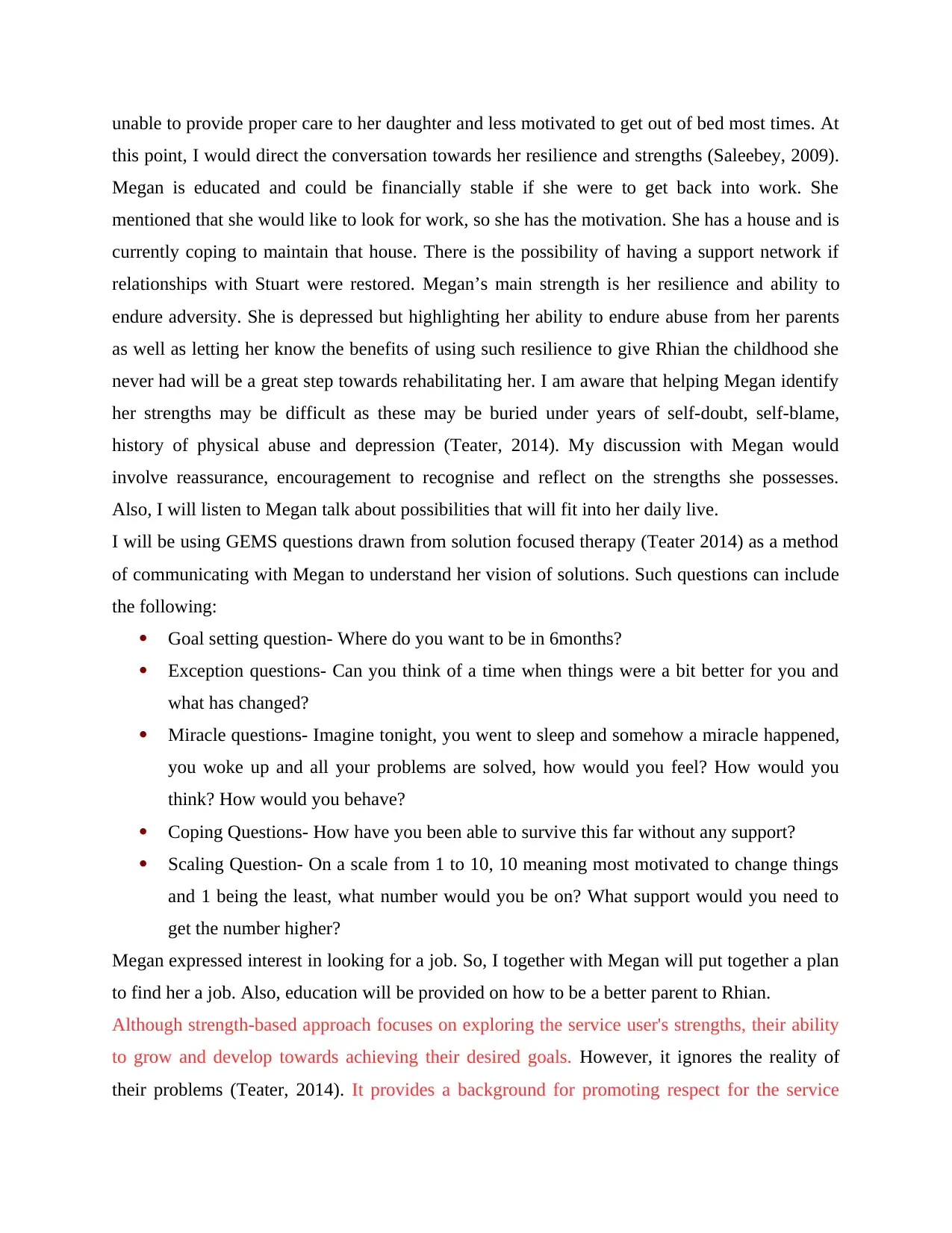
unable to provide proper care to her daughter and less motivated to get out of bed most times. At
this point, I would direct the conversation towards her resilience and strengths (Saleebey, 2009).
Megan is educated and could be financially stable if she were to get back into work. She
mentioned that she would like to look for work, so she has the motivation. She has a house and is
currently coping to maintain that house. There is the possibility of having a support network if
relationships with Stuart were restored. Megan’s main strength is her resilience and ability to
endure adversity. She is depressed but highlighting her ability to endure abuse from her parents
as well as letting her know the benefits of using such resilience to give Rhian the childhood she
never had will be a great step towards rehabilitating her. I am aware that helping Megan identify
her strengths may be difficult as these may be buried under years of self-doubt, self-blame,
history of physical abuse and depression (Teater, 2014). My discussion with Megan would
involve reassurance, encouragement to recognise and reflect on the strengths she possesses.
Also, I will listen to Megan talk about possibilities that will fit into her daily live.
I will be using GEMS questions drawn from solution focused therapy (Teater 2014) as a method
of communicating with Megan to understand her vision of solutions. Such questions can include
the following:
Goal setting question- Where do you want to be in 6months?
Exception questions- Can you think of a time when things were a bit better for you and
what has changed?
Miracle questions- Imagine tonight, you went to sleep and somehow a miracle happened,
you woke up and all your problems are solved, how would you feel? How would you
think? How would you behave?
Coping Questions- How have you been able to survive this far without any support?
Scaling Question- On a scale from 1 to 10, 10 meaning most motivated to change things
and 1 being the least, what number would you be on? What support would you need to
get the number higher?
Megan expressed interest in looking for a job. So, I together with Megan will put together a plan
to find her a job. Also, education will be provided on how to be a better parent to Rhian.
Although strength-based approach focuses on exploring the service user's strengths, their ability
to grow and develop towards achieving their desired goals. However, it ignores the reality of
their problems (Teater, 2014). It provides a background for promoting respect for the service
this point, I would direct the conversation towards her resilience and strengths (Saleebey, 2009).
Megan is educated and could be financially stable if she were to get back into work. She
mentioned that she would like to look for work, so she has the motivation. She has a house and is
currently coping to maintain that house. There is the possibility of having a support network if
relationships with Stuart were restored. Megan’s main strength is her resilience and ability to
endure adversity. She is depressed but highlighting her ability to endure abuse from her parents
as well as letting her know the benefits of using such resilience to give Rhian the childhood she
never had will be a great step towards rehabilitating her. I am aware that helping Megan identify
her strengths may be difficult as these may be buried under years of self-doubt, self-blame,
history of physical abuse and depression (Teater, 2014). My discussion with Megan would
involve reassurance, encouragement to recognise and reflect on the strengths she possesses.
Also, I will listen to Megan talk about possibilities that will fit into her daily live.
I will be using GEMS questions drawn from solution focused therapy (Teater 2014) as a method
of communicating with Megan to understand her vision of solutions. Such questions can include
the following:
Goal setting question- Where do you want to be in 6months?
Exception questions- Can you think of a time when things were a bit better for you and
what has changed?
Miracle questions- Imagine tonight, you went to sleep and somehow a miracle happened,
you woke up and all your problems are solved, how would you feel? How would you
think? How would you behave?
Coping Questions- How have you been able to survive this far without any support?
Scaling Question- On a scale from 1 to 10, 10 meaning most motivated to change things
and 1 being the least, what number would you be on? What support would you need to
get the number higher?
Megan expressed interest in looking for a job. So, I together with Megan will put together a plan
to find her a job. Also, education will be provided on how to be a better parent to Rhian.
Although strength-based approach focuses on exploring the service user's strengths, their ability
to grow and develop towards achieving their desired goals. However, it ignores the reality of
their problems (Teater, 2014). It provides a background for promoting respect for the service
⊘ This is a preview!⊘
Do you want full access?
Subscribe today to unlock all pages.

Trusted by 1+ million students worldwide

user's capabilities and potentials. It fails to recognise the structural barriers to service user
empowerment (Healy, 2014). Strengths-based approach encourages the service users to find
solutions to their own problems without taking into consideration the cultural and community
contexts of the problem. It does not encourage the social workers to challenge the structures that
cause the problems (Teater, 2014). Gray (2011) argues that the strength-based approach reduces
the responsibility of the state welfare system to care for service users because its viewpoint of
reality is neo-liberal.
Task-centred Practice
The task-centred practice is a short-term approach used by social workers. It is mainly focused
on improving specific problems of service users (Fortune and Reid; 2011 Reid and Epstein,
1972). Task-centred practice is appreciated by service users who prefer more direction. It is a
applicable approach in a consulting manner kind of work which is valued and preferred by
clients. It attracts and beneficial for people who wants more directions than compared with
therapeutic approaches which touches emotional aspect and interpersonal problems. (Payne,
2014).
Applying the task centred practice in the case of Megan, I would approach Megan with empathy,
moving beyond the immediate concerns presented in the referral. I would listen to her as she tells
me about her current situation and what support she needs moving forward. (Payne,2014). Doing
so might identify some issues that are not present in the referral. Megan and I will work together
to identify her problems which include child neglect, lack of provision for basic care needs of
Rhian like warm meals, unemployment, depression and no support network. Bearing in mind the
three important requirements specification of her problems, her consent and support network to
tackle the problem listed above, Megan’s consent is very important. According to Marsh and
Doel (2005), Megan would need to acknowledge the problems and show a willingness to work
on it. With support, Megan is in position to solve her problem. The problem must be specific and
relatively limited in scope.
Having identified the problems above, I would ask Megan what her desired goals are. In defining
Megan’s goals, I will be using SMART goals, an acronym for specific, measurable, achievable,
realistic and timely as a guide (Marsh and Doel, 2005). Megan should be able to complete the set
goals without too much support from others. Thereby, the goal needs to be realistic and
achievable. Megan’s goals could be getting a job and being a better parent to address the issue of
empowerment (Healy, 2014). Strengths-based approach encourages the service users to find
solutions to their own problems without taking into consideration the cultural and community
contexts of the problem. It does not encourage the social workers to challenge the structures that
cause the problems (Teater, 2014). Gray (2011) argues that the strength-based approach reduces
the responsibility of the state welfare system to care for service users because its viewpoint of
reality is neo-liberal.
Task-centred Practice
The task-centred practice is a short-term approach used by social workers. It is mainly focused
on improving specific problems of service users (Fortune and Reid; 2011 Reid and Epstein,
1972). Task-centred practice is appreciated by service users who prefer more direction. It is a
applicable approach in a consulting manner kind of work which is valued and preferred by
clients. It attracts and beneficial for people who wants more directions than compared with
therapeutic approaches which touches emotional aspect and interpersonal problems. (Payne,
2014).
Applying the task centred practice in the case of Megan, I would approach Megan with empathy,
moving beyond the immediate concerns presented in the referral. I would listen to her as she tells
me about her current situation and what support she needs moving forward. (Payne,2014). Doing
so might identify some issues that are not present in the referral. Megan and I will work together
to identify her problems which include child neglect, lack of provision for basic care needs of
Rhian like warm meals, unemployment, depression and no support network. Bearing in mind the
three important requirements specification of her problems, her consent and support network to
tackle the problem listed above, Megan’s consent is very important. According to Marsh and
Doel (2005), Megan would need to acknowledge the problems and show a willingness to work
on it. With support, Megan is in position to solve her problem. The problem must be specific and
relatively limited in scope.
Having identified the problems above, I would ask Megan what her desired goals are. In defining
Megan’s goals, I will be using SMART goals, an acronym for specific, measurable, achievable,
realistic and timely as a guide (Marsh and Doel, 2005). Megan should be able to complete the set
goals without too much support from others. Thereby, the goal needs to be realistic and
achievable. Megan’s goals could be getting a job and being a better parent to address the issue of
Paraphrase This Document
Need a fresh take? Get an instant paraphrase of this document with our AI Paraphraser
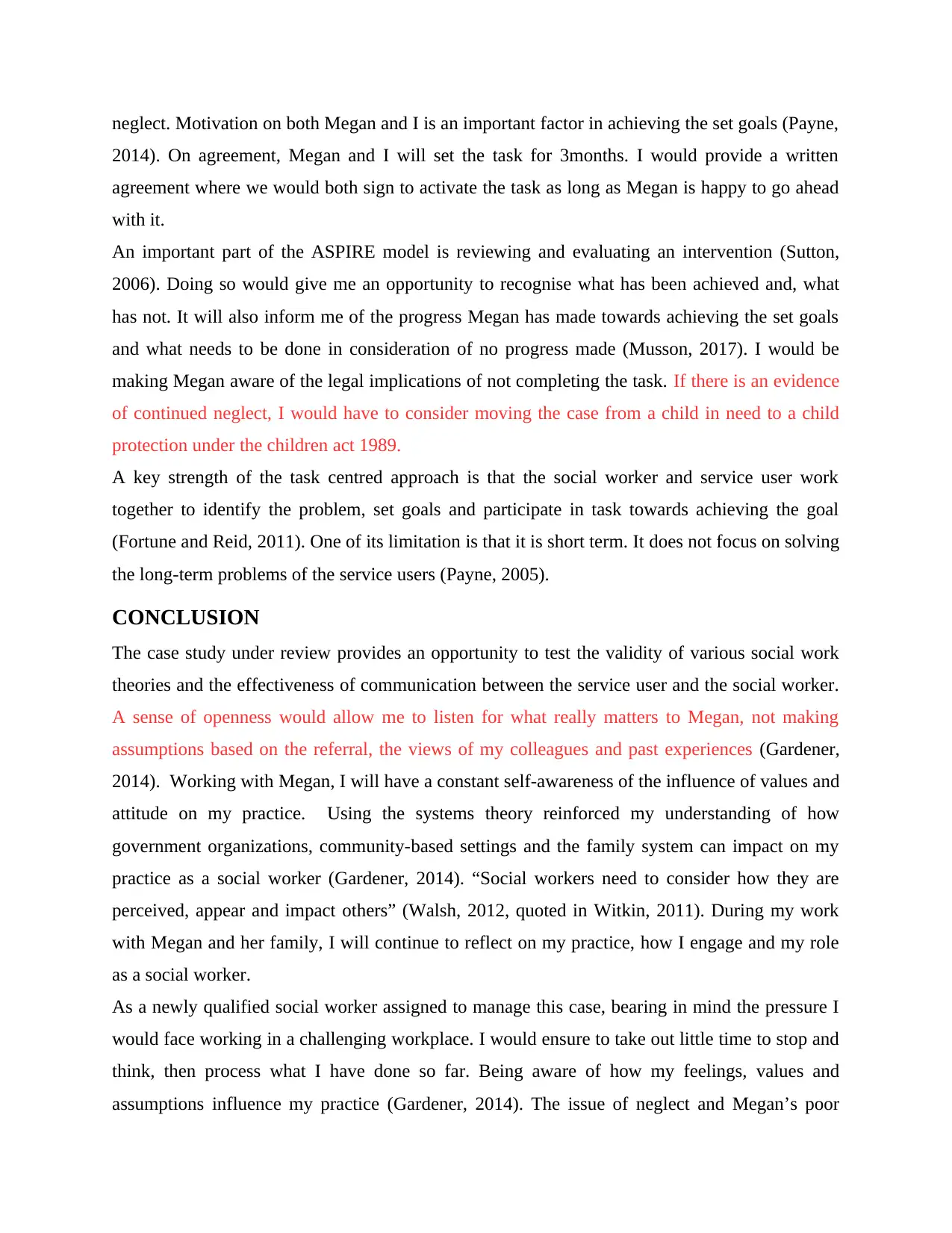
neglect. Motivation on both Megan and I is an important factor in achieving the set goals (Payne,
2014). On agreement, Megan and I will set the task for 3months. I would provide a written
agreement where we would both sign to activate the task as long as Megan is happy to go ahead
with it.
An important part of the ASPIRE model is reviewing and evaluating an intervention (Sutton,
2006). Doing so would give me an opportunity to recognise what has been achieved and, what
has not. It will also inform me of the progress Megan has made towards achieving the set goals
and what needs to be done in consideration of no progress made (Musson, 2017). I would be
making Megan aware of the legal implications of not completing the task. If there is an evidence
of continued neglect, I would have to consider moving the case from a child in need to a child
protection under the children act 1989.
A key strength of the task centred approach is that the social worker and service user work
together to identify the problem, set goals and participate in task towards achieving the goal
(Fortune and Reid, 2011). One of its limitation is that it is short term. It does not focus on solving
the long-term problems of the service users (Payne, 2005).
CONCLUSION
The case study under review provides an opportunity to test the validity of various social work
theories and the effectiveness of communication between the service user and the social worker.
A sense of openness would allow me to listen for what really matters to Megan, not making
assumptions based on the referral, the views of my colleagues and past experiences (Gardener,
2014). Working with Megan, I will have a constant self-awareness of the influence of values and
attitude on my practice. Using the systems theory reinforced my understanding of how
government organizations, community-based settings and the family system can impact on my
practice as a social worker (Gardener, 2014). “Social workers need to consider how they are
perceived, appear and impact others” (Walsh, 2012, quoted in Witkin, 2011). During my work
with Megan and her family, I will continue to reflect on my practice, how I engage and my role
as a social worker.
As a newly qualified social worker assigned to manage this case, bearing in mind the pressure I
would face working in a challenging workplace. I would ensure to take out little time to stop and
think, then process what I have done so far. Being aware of how my feelings, values and
assumptions influence my practice (Gardener, 2014). The issue of neglect and Megan’s poor
2014). On agreement, Megan and I will set the task for 3months. I would provide a written
agreement where we would both sign to activate the task as long as Megan is happy to go ahead
with it.
An important part of the ASPIRE model is reviewing and evaluating an intervention (Sutton,
2006). Doing so would give me an opportunity to recognise what has been achieved and, what
has not. It will also inform me of the progress Megan has made towards achieving the set goals
and what needs to be done in consideration of no progress made (Musson, 2017). I would be
making Megan aware of the legal implications of not completing the task. If there is an evidence
of continued neglect, I would have to consider moving the case from a child in need to a child
protection under the children act 1989.
A key strength of the task centred approach is that the social worker and service user work
together to identify the problem, set goals and participate in task towards achieving the goal
(Fortune and Reid, 2011). One of its limitation is that it is short term. It does not focus on solving
the long-term problems of the service users (Payne, 2005).
CONCLUSION
The case study under review provides an opportunity to test the validity of various social work
theories and the effectiveness of communication between the service user and the social worker.
A sense of openness would allow me to listen for what really matters to Megan, not making
assumptions based on the referral, the views of my colleagues and past experiences (Gardener,
2014). Working with Megan, I will have a constant self-awareness of the influence of values and
attitude on my practice. Using the systems theory reinforced my understanding of how
government organizations, community-based settings and the family system can impact on my
practice as a social worker (Gardener, 2014). “Social workers need to consider how they are
perceived, appear and impact others” (Walsh, 2012, quoted in Witkin, 2011). During my work
with Megan and her family, I will continue to reflect on my practice, how I engage and my role
as a social worker.
As a newly qualified social worker assigned to manage this case, bearing in mind the pressure I
would face working in a challenging workplace. I would ensure to take out little time to stop and
think, then process what I have done so far. Being aware of how my feelings, values and
assumptions influence my practice (Gardener, 2014). The issue of neglect and Megan’s poor
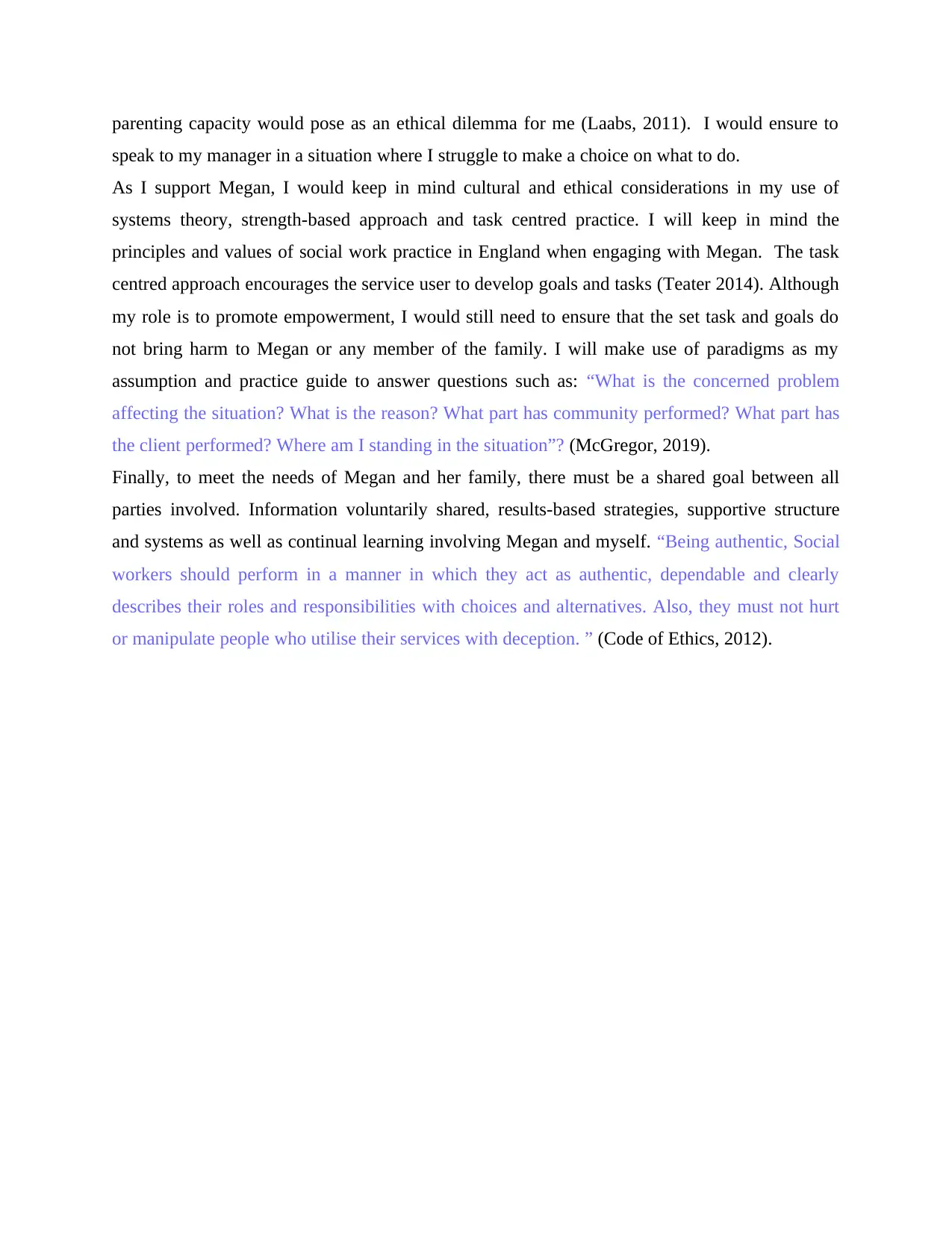
parenting capacity would pose as an ethical dilemma for me (Laabs, 2011). I would ensure to
speak to my manager in a situation where I struggle to make a choice on what to do.
As I support Megan, I would keep in mind cultural and ethical considerations in my use of
systems theory, strength-based approach and task centred practice. I will keep in mind the
principles and values of social work practice in England when engaging with Megan. The task
centred approach encourages the service user to develop goals and tasks (Teater 2014). Although
my role is to promote empowerment, I would still need to ensure that the set task and goals do
not bring harm to Megan or any member of the family. I will make use of paradigms as my
assumption and practice guide to answer questions such as: “What is the concerned problem
affecting the situation? What is the reason? What part has community performed? What part has
the client performed? Where am I standing in the situation”? (McGregor, 2019).
Finally, to meet the needs of Megan and her family, there must be a shared goal between all
parties involved. Information voluntarily shared, results-based strategies, supportive structure
and systems as well as continual learning involving Megan and myself. “Being authentic, Social
workers should perform in a manner in which they act as authentic, dependable and clearly
describes their roles and responsibilities with choices and alternatives. Also, they must not hurt
or manipulate people who utilise their services with deception. ” (Code of Ethics, 2012).
speak to my manager in a situation where I struggle to make a choice on what to do.
As I support Megan, I would keep in mind cultural and ethical considerations in my use of
systems theory, strength-based approach and task centred practice. I will keep in mind the
principles and values of social work practice in England when engaging with Megan. The task
centred approach encourages the service user to develop goals and tasks (Teater 2014). Although
my role is to promote empowerment, I would still need to ensure that the set task and goals do
not bring harm to Megan or any member of the family. I will make use of paradigms as my
assumption and practice guide to answer questions such as: “What is the concerned problem
affecting the situation? What is the reason? What part has community performed? What part has
the client performed? Where am I standing in the situation”? (McGregor, 2019).
Finally, to meet the needs of Megan and her family, there must be a shared goal between all
parties involved. Information voluntarily shared, results-based strategies, supportive structure
and systems as well as continual learning involving Megan and myself. “Being authentic, Social
workers should perform in a manner in which they act as authentic, dependable and clearly
describes their roles and responsibilities with choices and alternatives. Also, they must not hurt
or manipulate people who utilise their services with deception. ” (Code of Ethics, 2012).
⊘ This is a preview!⊘
Do you want full access?
Subscribe today to unlock all pages.

Trusted by 1+ million students worldwide
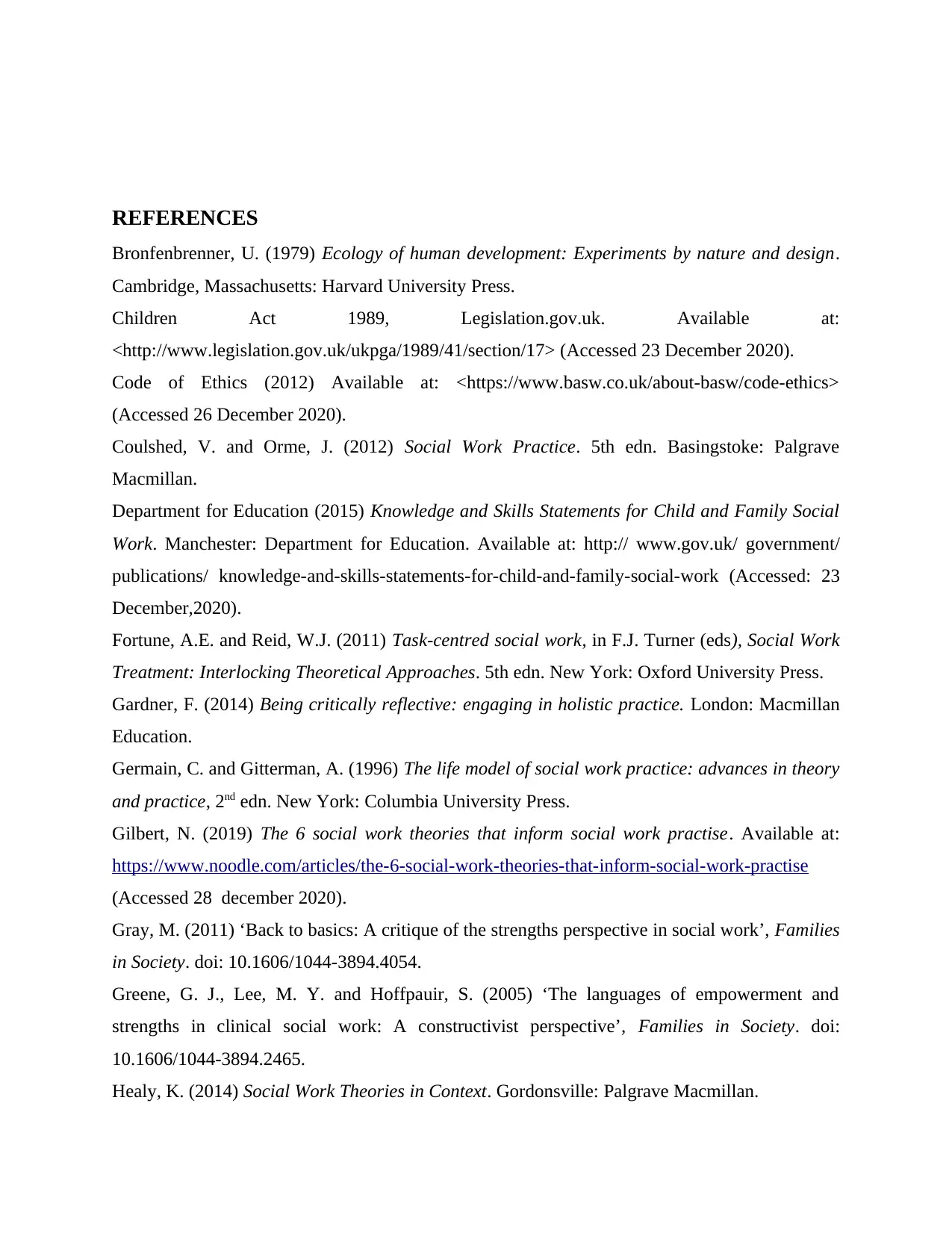
REFERENCES
Bronfenbrenner, U. (1979) Ecology of human development: Experiments by nature and design.
Cambridge, Massachusetts: Harvard University Press.
Children Act 1989, Legislation.gov.uk. Available at:
<http://www.legislation.gov.uk/ukpga/1989/41/section/17> (Accessed 23 December 2020).
Code of Ethics (2012) Available at: <https://www.basw.co.uk/about-basw/code-ethics>
(Accessed 26 December 2020).
Coulshed, V. and Orme, J. (2012) Social Work Practice. 5th edn. Basingstoke: Palgrave
Macmillan.
Department for Education (2015) Knowledge and Skills Statements for Child and Family Social
Work. Manchester: Department for Education. Available at: http:// www.gov.uk/ government/
publications/ knowledge-and-skills-statements-for-child-and-family-social-work (Accessed: 23
December,2020).
Fortune, A.E. and Reid, W.J. (2011) Task-centred social work, in F.J. Turner (eds), Social Work
Treatment: Interlocking Theoretical Approaches. 5th edn. New York: Oxford University Press.
Gardner, F. (2014) Being critically reflective: engaging in holistic practice. London: Macmillan
Education.
Germain, C. and Gitterman, A. (1996) The life model of social work practice: advances in theory
and practice, 2nd edn. New York: Columbia University Press.
Gilbert, N. (2019) The 6 social work theories that inform social work practise. Available at:
https://www.noodle.com/articles/the-6-social-work-theories-that-inform-social-work-practise
(Accessed 28 december 2020).
Gray, M. (2011) ‘Back to basics: A critique of the strengths perspective in social work’, Families
in Society. doi: 10.1606/1044-3894.4054.
Greene, G. J., Lee, M. Y. and Hoffpauir, S. (2005) ‘The languages of empowerment and
strengths in clinical social work: A constructivist perspective’, Families in Society. doi:
10.1606/1044-3894.2465.
Healy, K. (2014) Social Work Theories in Context. Gordonsville: Palgrave Macmillan.
Bronfenbrenner, U. (1979) Ecology of human development: Experiments by nature and design.
Cambridge, Massachusetts: Harvard University Press.
Children Act 1989, Legislation.gov.uk. Available at:
<http://www.legislation.gov.uk/ukpga/1989/41/section/17> (Accessed 23 December 2020).
Code of Ethics (2012) Available at: <https://www.basw.co.uk/about-basw/code-ethics>
(Accessed 26 December 2020).
Coulshed, V. and Orme, J. (2012) Social Work Practice. 5th edn. Basingstoke: Palgrave
Macmillan.
Department for Education (2015) Knowledge and Skills Statements for Child and Family Social
Work. Manchester: Department for Education. Available at: http:// www.gov.uk/ government/
publications/ knowledge-and-skills-statements-for-child-and-family-social-work (Accessed: 23
December,2020).
Fortune, A.E. and Reid, W.J. (2011) Task-centred social work, in F.J. Turner (eds), Social Work
Treatment: Interlocking Theoretical Approaches. 5th edn. New York: Oxford University Press.
Gardner, F. (2014) Being critically reflective: engaging in holistic practice. London: Macmillan
Education.
Germain, C. and Gitterman, A. (1996) The life model of social work practice: advances in theory
and practice, 2nd edn. New York: Columbia University Press.
Gilbert, N. (2019) The 6 social work theories that inform social work practise. Available at:
https://www.noodle.com/articles/the-6-social-work-theories-that-inform-social-work-practise
(Accessed 28 december 2020).
Gray, M. (2011) ‘Back to basics: A critique of the strengths perspective in social work’, Families
in Society. doi: 10.1606/1044-3894.4054.
Greene, G. J., Lee, M. Y. and Hoffpauir, S. (2005) ‘The languages of empowerment and
strengths in clinical social work: A constructivist perspective’, Families in Society. doi:
10.1606/1044-3894.2465.
Healy, K. (2014) Social Work Theories in Context. Gordonsville: Palgrave Macmillan.
Paraphrase This Document
Need a fresh take? Get an instant paraphrase of this document with our AI Paraphraser
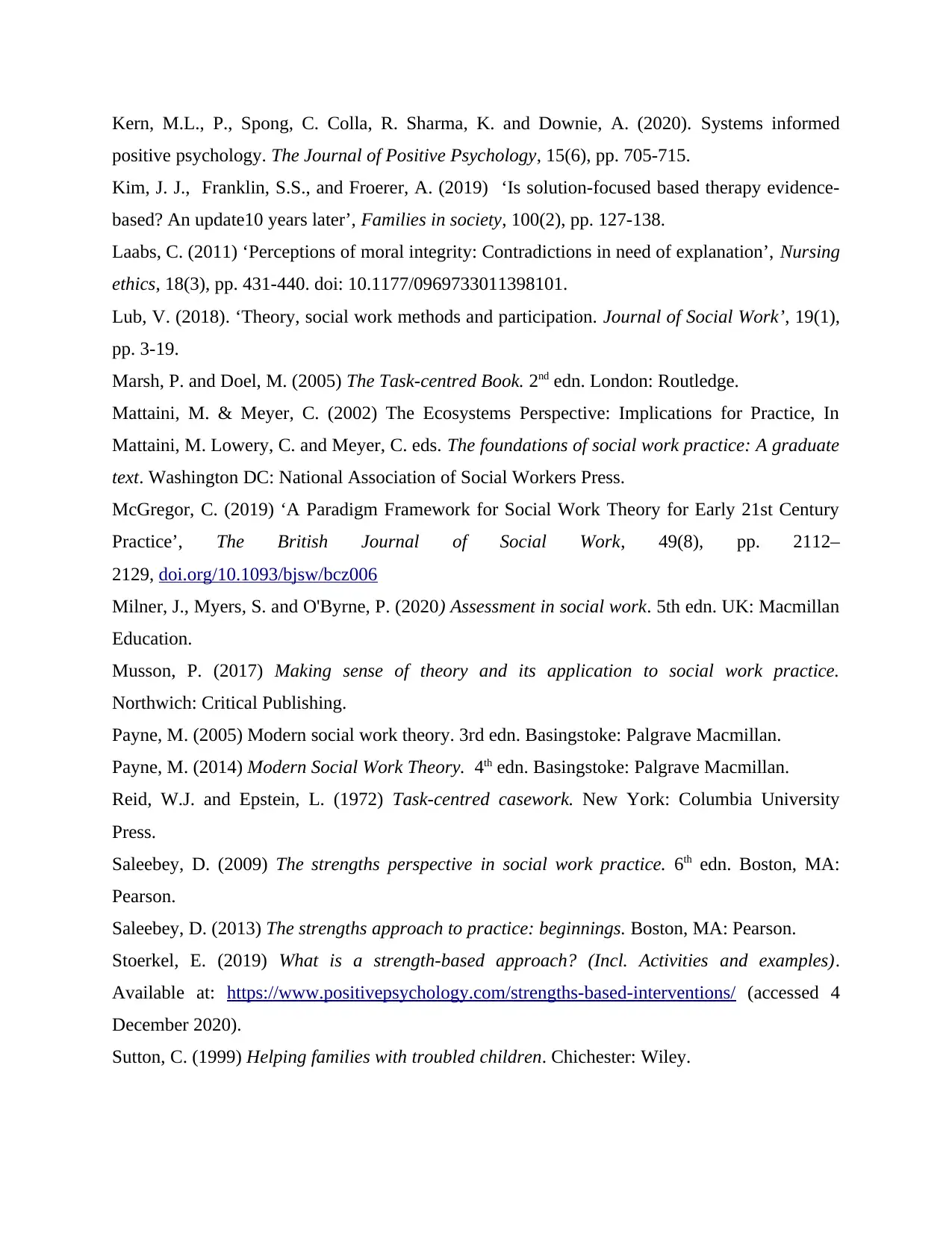
Kern, M.L., P., Spong, C. Colla, R. Sharma, K. and Downie, A. (2020). Systems informed
positive psychology. The Journal of Positive Psychology, 15(6), pp. 705-715.
Kim, J. J., Franklin, S.S., and Froerer, A. (2019) ‘Is solution-focused based therapy evidence-
based? An update10 years later’, Families in society, 100(2), pp. 127-138.
Laabs, C. (2011) ‘Perceptions of moral integrity: Contradictions in need of explanation’, Nursing
ethics, 18(3), pp. 431-440. doi: 10.1177/0969733011398101.
Lub, V. (2018). ‘Theory, social work methods and participation. Journal of Social Work’, 19(1),
pp. 3-19.
Marsh, P. and Doel, M. (2005) The Task-centred Book. 2nd edn. London: Routledge.
Mattaini, M. & Meyer, C. (2002) The Ecosystems Perspective: Implications for Practice, In
Mattaini, M. Lowery, C. and Meyer, C. eds. The foundations of social work practice: A graduate
text. Washington DC: National Association of Social Workers Press.
McGregor, C. (2019) ‘A Paradigm Framework for Social Work Theory for Early 21st Century
Practice’, The British Journal of Social Work, 49(8), pp. 2112–
2129, doi.org/10.1093/bjsw/bcz006
Milner, J., Myers, S. and O'Byrne, P. (2020) Assessment in social work. 5th edn. UK: Macmillan
Education.
Musson, P. (2017) Making sense of theory and its application to social work practice.
Northwich: Critical Publishing.
Payne, M. (2005) Modern social work theory. 3rd edn. Basingstoke: Palgrave Macmillan.
Payne, M. (2014) Modern Social Work Theory. 4th edn. Basingstoke: Palgrave Macmillan.
Reid, W.J. and Epstein, L. (1972) Task-centred casework. New York: Columbia University
Press.
Saleebey, D. (2009) The strengths perspective in social work practice. 6th edn. Boston, MA:
Pearson.
Saleebey, D. (2013) The strengths approach to practice: beginnings. Boston, MA: Pearson.
Stoerkel, E. (2019) What is a strength-based approach? (Incl. Activities and examples).
Available at: https://www.positivepsychology.com/strengths-based-interventions/ (accessed 4
December 2020).
Sutton, C. (1999) Helping families with troubled children. Chichester: Wiley.
positive psychology. The Journal of Positive Psychology, 15(6), pp. 705-715.
Kim, J. J., Franklin, S.S., and Froerer, A. (2019) ‘Is solution-focused based therapy evidence-
based? An update10 years later’, Families in society, 100(2), pp. 127-138.
Laabs, C. (2011) ‘Perceptions of moral integrity: Contradictions in need of explanation’, Nursing
ethics, 18(3), pp. 431-440. doi: 10.1177/0969733011398101.
Lub, V. (2018). ‘Theory, social work methods and participation. Journal of Social Work’, 19(1),
pp. 3-19.
Marsh, P. and Doel, M. (2005) The Task-centred Book. 2nd edn. London: Routledge.
Mattaini, M. & Meyer, C. (2002) The Ecosystems Perspective: Implications for Practice, In
Mattaini, M. Lowery, C. and Meyer, C. eds. The foundations of social work practice: A graduate
text. Washington DC: National Association of Social Workers Press.
McGregor, C. (2019) ‘A Paradigm Framework for Social Work Theory for Early 21st Century
Practice’, The British Journal of Social Work, 49(8), pp. 2112–
2129, doi.org/10.1093/bjsw/bcz006
Milner, J., Myers, S. and O'Byrne, P. (2020) Assessment in social work. 5th edn. UK: Macmillan
Education.
Musson, P. (2017) Making sense of theory and its application to social work practice.
Northwich: Critical Publishing.
Payne, M. (2005) Modern social work theory. 3rd edn. Basingstoke: Palgrave Macmillan.
Payne, M. (2014) Modern Social Work Theory. 4th edn. Basingstoke: Palgrave Macmillan.
Reid, W.J. and Epstein, L. (1972) Task-centred casework. New York: Columbia University
Press.
Saleebey, D. (2009) The strengths perspective in social work practice. 6th edn. Boston, MA:
Pearson.
Saleebey, D. (2013) The strengths approach to practice: beginnings. Boston, MA: Pearson.
Stoerkel, E. (2019) What is a strength-based approach? (Incl. Activities and examples).
Available at: https://www.positivepsychology.com/strengths-based-interventions/ (accessed 4
December 2020).
Sutton, C. (1999) Helping families with troubled children. Chichester: Wiley.
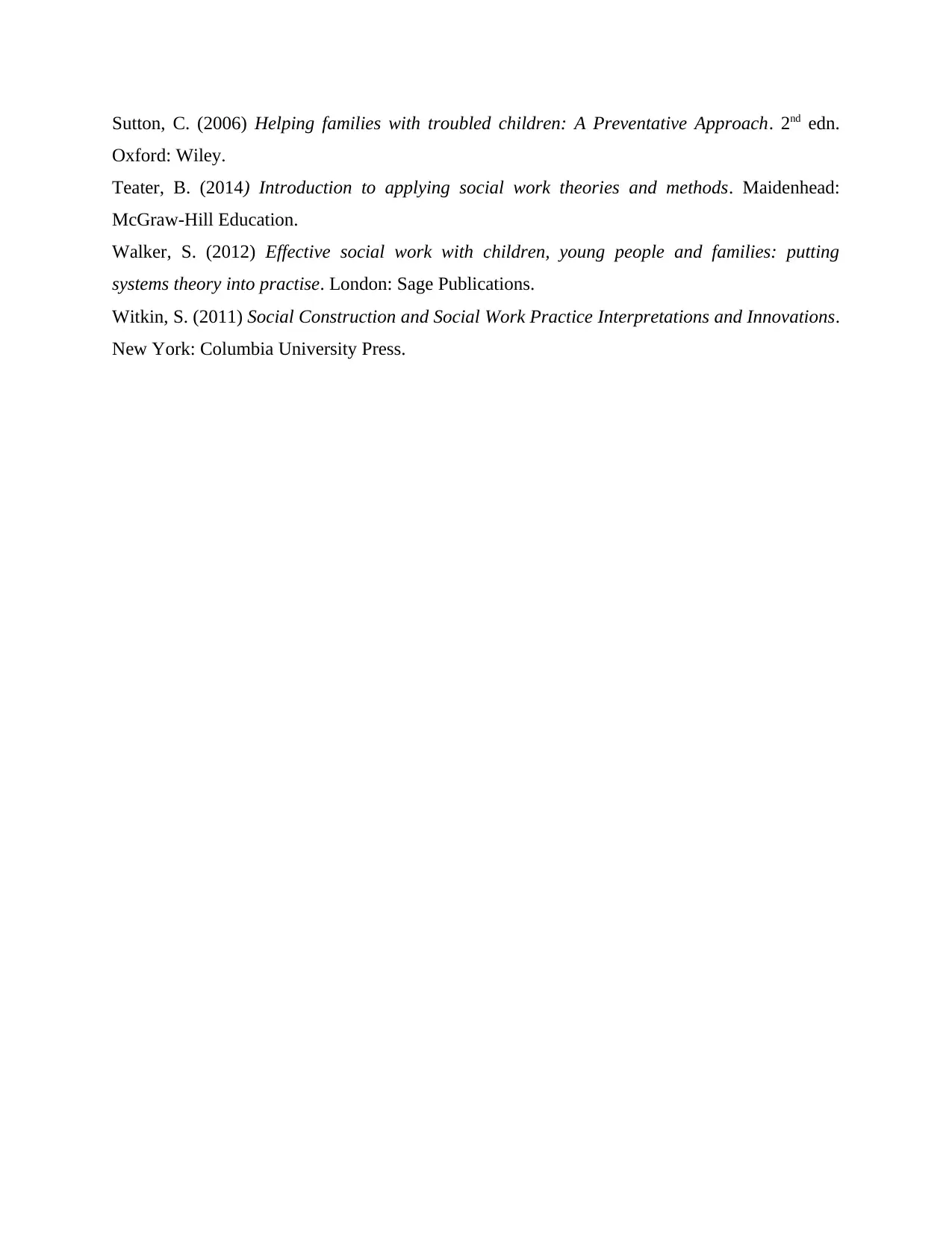
Sutton, C. (2006) Helping families with troubled children: A Preventative Approach. 2nd edn.
Oxford: Wiley.
Teater, B. (2014) Introduction to applying social work theories and methods. Maidenhead:
McGraw-Hill Education.
Walker, S. (2012) Effective social work with children, young people and families: putting
systems theory into practise. London: Sage Publications.
Witkin, S. (2011) Social Construction and Social Work Practice Interpretations and Innovations.
New York: Columbia University Press.
Oxford: Wiley.
Teater, B. (2014) Introduction to applying social work theories and methods. Maidenhead:
McGraw-Hill Education.
Walker, S. (2012) Effective social work with children, young people and families: putting
systems theory into practise. London: Sage Publications.
Witkin, S. (2011) Social Construction and Social Work Practice Interpretations and Innovations.
New York: Columbia University Press.
⊘ This is a preview!⊘
Do you want full access?
Subscribe today to unlock all pages.

Trusted by 1+ million students worldwide
1 out of 15
Related Documents
Your All-in-One AI-Powered Toolkit for Academic Success.
+13062052269
info@desklib.com
Available 24*7 on WhatsApp / Email
![[object Object]](/_next/static/media/star-bottom.7253800d.svg)
Unlock your academic potential
© 2024 | Zucol Services PVT LTD | All rights reserved.





